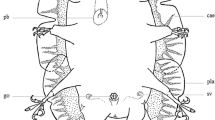Abstract
A new species of marine tardigrade is described coming from the muddy sediment of the Antarctic deep sea. Angursa antarctica sp. nov. is characterized by the presence of balloon-shaped primary clavae, long lateral cirri, long cephalic cirri, spines on legs I, hemispherical capsule-shaped papillae on legs IV, and short external peduncles. Geographical distribution of the genus Angursa extends to Antarctic waters, suggesting a cosmopolitan distribution for this bathyal and abyssal genus. A table comparing the main differentiating characteristics of the species of Angursa is presented.
Similar content being viewed by others
Author information
Authors and Affiliations
Additional information
Received: 25 July 1997 / Accepted: 9 November 1997
Rights and permissions
About this article
Cite this article
Víllora-Moreno, S. Deep-sea Tardigrada from South Shetland Islands (Antarctica) with description of Angursa antarctica sp. nov. (Arthrotardigrada, Halechiniscidae). Polar Biol 19, 336–341 (1998). https://doi.org/10.1007/s003000050255
Issue Date:
DOI: https://doi.org/10.1007/s003000050255




